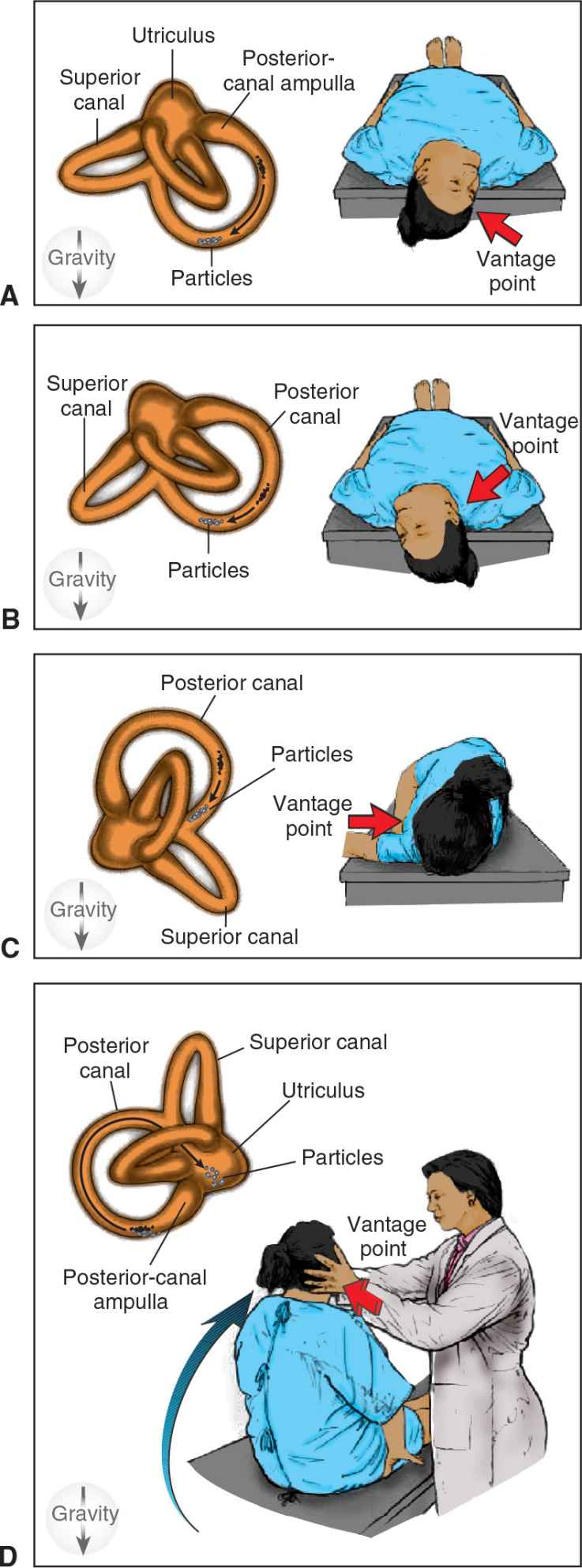![]() Used to treat posterior canal benign paroxysmal positional vertigo (BPPV) that has been confirmed through a positive Hallpike test (upbeat, ipsilateral, and torsional nystagmus in the head-hanging position)
Used to treat posterior canal benign paroxysmal positional vertigo (BPPV) that has been confirmed through a positive Hallpike test (upbeat, ipsilateral, and torsional nystagmus in the head-hanging position)
![]() This is also known as the canalith repositioning maneuver and the “modified” Epley maneuver (the originally described maneuver used premedication and had fewer steps)
This is also known as the canalith repositioning maneuver and the “modified” Epley maneuver (the originally described maneuver used premedication and had fewer steps)
CONTRAINDICATIONS
![]() Unstable heart disease
Unstable heart disease
![]() Ongoing cerebrovascular ischemia
Ongoing cerebrovascular ischemia
![]() Severe neck disease
Severe neck disease
![]() High-grade carotid stenosis
High-grade carotid stenosis
RISKS/CONSENT ISSUES
![]() There have been no reported serious adverse events such as neck fracture or carotid artery dissection
There have been no reported serious adverse events such as neck fracture or carotid artery dissection
![]() Warn the patient that he will likely become symptomatic during the various head maneuvers, but that this will be transient
Warn the patient that he will likely become symptomatic during the various head maneuvers, but that this will be transient
![]() Rarely the patient may vomit. In general, premedication is not needed.
Rarely the patient may vomit. In general, premedication is not needed.
LANDMARKS
The Epley maneuver is a four- to five-step maneuver that moves the otoliths in the plane of the posterior semicircular canal back into the utricle (FIGURE 46.1).
TECHNIQUE
![]() Patient is sitting upright in the gurney and positioned far enough back such that when he lies down, his head will overhang the edge of the gurney
Patient is sitting upright in the gurney and positioned far enough back such that when he lies down, his head will overhang the edge of the gurney
![]() Turn the patient’s head 45 degrees to the side that was positive during the Hallpike test, which was performed to confirm the diagnosis of posterior canal BPPV
Turn the patient’s head 45 degrees to the side that was positive during the Hallpike test, which was performed to confirm the diagnosis of posterior canal BPPV
![]() Lower the guardrail of the gurney on the opposite side to which you have turned the patient’s head. Warn the patient that you are going to lower him and that he will become symptomatic.
Lower the guardrail of the gurney on the opposite side to which you have turned the patient’s head. Warn the patient that you are going to lower him and that he will become symptomatic.
![]() Place the patient in the head-hanging position, supporting the patient’s head with your hands. This does not need to be done rapidly but should be done over several seconds. This step is identical to performing the Hallpike test.
Place the patient in the head-hanging position, supporting the patient’s head with your hands. This does not need to be done rapidly but should be done over several seconds. This step is identical to performing the Hallpike test.
![]() Keep the patient in the head-hanging position until the nystagmus and symptoms resolve, or at least for 30 seconds
Keep the patient in the head-hanging position until the nystagmus and symptoms resolve, or at least for 30 seconds
![]() Turn the patient’s head 90 degrees to the other side. Again, hold this position for 30 seconds or until the nystagmus and vertigo resolve.
Turn the patient’s head 90 degrees to the other side. Again, hold this position for 30 seconds or until the nystagmus and vertigo resolve.
![]() Tell the patient to roll onto his side and turn his head so that he is looking at the floor. Try to keep the head in the dependent position throughout. Hold this position for at least 30 seconds or until the vertigo resolves.
Tell the patient to roll onto his side and turn his head so that he is looking at the floor. Try to keep the head in the dependent position throughout. Hold this position for at least 30 seconds or until the vertigo resolves.
![]() Sit the patient up with his legs extended over the side of the gurney (you previously lowered the guard rails on this side to allow for this) and tilt his head forward slightly
Sit the patient up with his legs extended over the side of the gurney (you previously lowered the guard rails on this side to allow for this) and tilt his head forward slightly
![]() You can tell the patient to put his hands on your shoulder in order to assist you in lifting him up to the sitting position
You can tell the patient to put his hands on your shoulder in order to assist you in lifting him up to the sitting position

FIGURE 46.1 Bedside maneuver for the treatment of a patient with benign paroxysmal positional vertigo affecting the right ear. (From Furman JM, Cass SP. Benign paroxysmal positional vertigo. N Engl J Med. 1999;341:1590–1596, with permission.)
Stay updated, free articles. Join our Telegram channel

Full access? Get Clinical Tree


